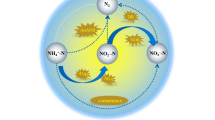Abstract
A pure culture of the obligately lithoautotrophic ammonia-oxidizer Nitrosomonas eutropha was grown in a laboratory-scale bioreactor with complete biomass retention. The air supply was supplemented with nitrogen dioxide (NO2; 25 or 50 ppm) or nitric oxide (NO; 25 or 50 ppm). Compared to cultures grown without these nitrogenous oxides, the addition of NO2 or NO to the culture resulted in a significant increase of the nitrification rate, specific activity of ammonia oxidation, growth rate, and maximum cell densities. In contrast, the growth yield slightly decreased in the presence of NO or NO2. Maximum cell densities of about 2 × 1010 cells ml–1 and a maximum nitrification rate of about 221 mmol NH4 + l–1 day–1 were obtained after 3 weeks in the presence of 50 ppm NO2. Furthermore, in the stationary phase about 50% of the nitrite produced was aerobically denitrified to dinitrogen (N2) and traces of nitrous oxide (N2O). When cells were supplemented with NO, a high rate of aerobic denitrification occurred only during the first days of the exponential growth phase.
Similar content being viewed by others

Author information
Authors and Affiliations
Additional information
Received: 12 May 1997 / Accepted: 10 November 1997
Rights and permissions
About this article
Cite this article
Zart, D., Bock, E. High rate of aerobic nitrification and denitrification by Nitrosomonas eutropha grown in a fermentor with complete biomass retention in the presence of gaseous NO2 or NO. Arch Microbiol 169, 282–286 (1998). https://doi.org/10.1007/s002030050573
Issue Date:
DOI: https://doi.org/10.1007/s002030050573



